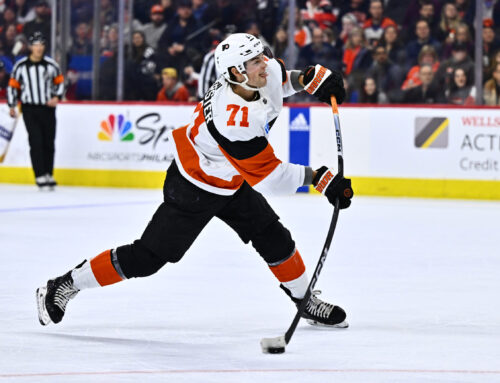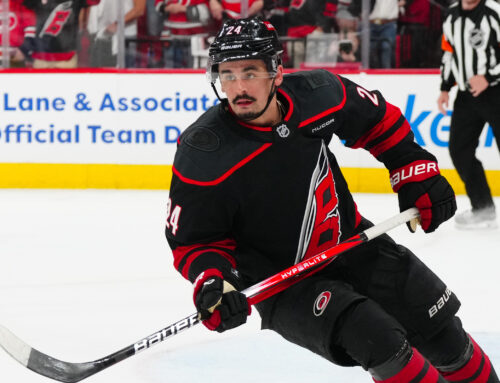
With the recent flurry of trades in the NHL, many have offered their opinions and insight, flooding the market with a substantial amount of surface level detail. Prior to Kris Versteeg’s recent trade to Philadelphia, I’ve always been a skeptic. This trade forced me to take a closer look though and determine some realistic expectations.
With my previous skepticism, I had dismissed many of Versteeg’s accomplishments. After all, he was merely a fifth round pick by the Boston Bruins in 2004, failed to ever crack Boston’s lineup, and was eventually traded to the Blackhawks for Brandon Bochenski. Nothing about this made me think he was a real winner. Then I looked closer.
At age 15, Versteeg was in his second year of Bantams and piled up 62 points in 36 games, not uncommon at the Bantam level. What surprised me though, was Versteeg’s 102 PIM that year. Kris took the leap next year to play with Lethbridge in the WHL, rather than playing Midget hockey. His points gradually increased, but in his final two years, he averaged 77 PIM per year (in 68 GP).
Versteeg’s fourth year in the WHL proved to be the biggest adjustment to his life. From 14-18, Kris had skated with the Lethbridge organization, but he was now beginning the season with Kamloops and after 14 games, he would be traded to Red Deer. In 57 games, Versteeg would register 36 points and 103 PIM. At the end of the season, he signs his first professional contract and debuts with the Providence Bruins in the AHL.
The fact that Versteeg was skating in Providence was a huge bonus for the Bruins, who couldn’t have expected much from their fifth round selection, now 20 years old entering 2006-07. Despite scoring above a point per game and keeping his attitude in check (19 PIM in 43 games), Versteeg was traded that year to Chicago. Moving on to Norfolk, Versteeg scored 23 points in 27 games and added 20 PIM, which is interesting considering he had only 19 in Providence.
Now Versteeg is only 21 years old, but he’s playing with a much more talented organization in the Chicago farm and he even gets a couple call ups for the Blackhawks. In 56 games in the AHL, Versteeg scores 49 points to go with his 174 PIM. Talk about a wild side! With each passing day, Versteeg is progressing and he can’t get enough. He begins the 2008-09 season with a full time spot on the Chicago Blackhawks at age 22 and he takes full advantage. He finishes with 53 points, second only to Bobby Ryan for rookie scoring. Versteeg finishes as one of the three Calder candidates and is starting to catch the attention of just about everyone who had written him off to this point in his career.
Kris falls victim to the sophomore slump slightly and registers 44 points in 79 games with 20 less penalty minutes than the previous year. The bright side is that in his two years of NHL experience, he strings together two very solid playoff runs, scoring a total of 26 points in 39 games and even picking up a Stanley Cup ring. In the coming offseason, Chicago is forced to re-shuffle their team and in the transition, Versteeg finds himself in Toronto.
Is Kris Versteeg a talented hockey player? No question about it. The kid’s great. The problem that he faced in Toronto was that they saw all of the stats I’ve quoted above and they assumed Versteeg was ready to make the jump as a go-to first liner. A closer look would’ve told them that every season Versteeg is successful is when he’s not the primary focus. He is at his best when skating on the second line. Eventually he may turn into a first line player, but that’s not something that should be rushed.
Many times the problem with having success early in a career is that people expect that success to multiply. Their eyes get big and the expectations simply become unrealistic. Toronto rolled the dice on Versteeg hoping he’d become the next Bobby Ryan, but unfortunately that’s not what happened. With the organization sitting 12th in the Eastern Conference, Brian Burke was ready to cut bait. Toronto fans wanted more and many Flyers fans thought it was too much. Funny how that works.
So here comes Kris Versteeg, ready to start the next chapter of his career. He is 24 years old, has won a Stanley Cup, and made the playoffs in both years he’s been in the league. What else is going on with him? Well, in Versteeg’s short career, he’s always worn #32. His childhood number was 10 and he wanted to take that number in Toronto, but felt it was a bad move wearing the number of former Leaf captain George Armstrong (apparently he has no problem wearing John LeClair’s number in Philadelphia). The number change is a great sign of Versteeg feeling comfortable in his new home and comfort is typically a prerequisite to confidence.
Next is the actual on-ice situation Versteeg will face in Philadelphia vs the one he faced in Toronto. He goes from a locker room where players have had personal vendettas with coach Ron Wilson to a locker room where the entire team has bought into the coaching of Peter Laviolette and the system is well structured. He is also no longer looked at to be one of the top offensive producers, but instead, he is relied upon to be a depth player. This is the exact scenario where Versteeg has thrived his entire career.
Lastly, Versteeg has a sandpaper side to him. From his bantam years on, he has posted over 100 penalty minutes three times in his career. Despite possessing that fiery attitude, he has also shown restraint, at many times in his career doing a great job staying out of the box. With those attributes, Flyers fans will fall in love with Versteeg as he will drop the gloves when needed while not taking stupid penalties and chipping in offense to boot. In all likelihood, Versteeg will score 20 goals again this year, which means he has scored 20 or more goals in every year he’s been in the league.
How did Versteeg feel about the move? Says Kris, “I thought I did my part there [Toronto], tried to play as hard as I could…but I couldn’t be happier with where I ended up here with the Flyers.”? The next logical question would be how the Flyers intend to use Versteeg, since that was an issue in Toronto. Peter Laviolette says “Sometimes you make a trade and you put all the burden on that person to change the direction. [Versteeg] gets an opportunity to come into a team that has a lot of talent right now and just add a nice complementary piece.”
Kris started out on a line with Mike Richards and Andreas Nodl. He had a couple nice chances, but the adjustment period could take some time. Laviolette will adjust his lines until he finds the right fit. In all likelihood, he’ll skate with Giroux, Carter, or Richards as his center and I’d expect him to really start clicking with about 10 games left in the season, carrying momentum into the playoffs. This is a great sign for current owners and a bad sign for potential investors. Acquiring Versteeg is likely going to get harder and harder from here on out.
When Versteeg starts clicking in Philly, which he will, he should score three points for every four games played. That’s a 62 point pace in a full year which I fully expect in 2011-12. The great thing about Philadelphia is the city loves the rough stuff. Versteeg could be a dark horse for some serious PIM contributions in the near future. Odds are he’ll make a great H2H playoff performer in 2010-11 and a valuable roto player in 2011-12.





 CHI
CHI N.J
N.J MTL
MTL CBJ
CBJ BOS
BOS PIT
PIT DET
DET ANA
ANA L.A
L.A COL
COL
